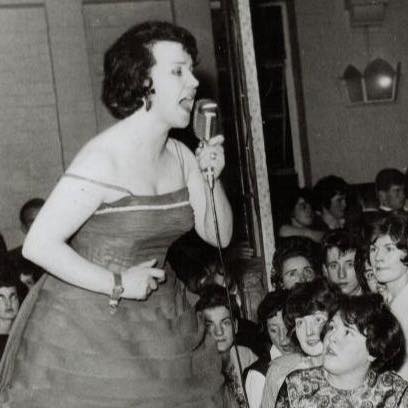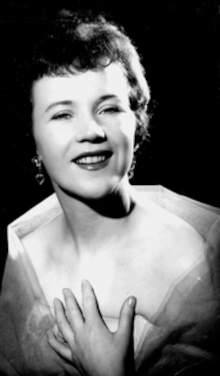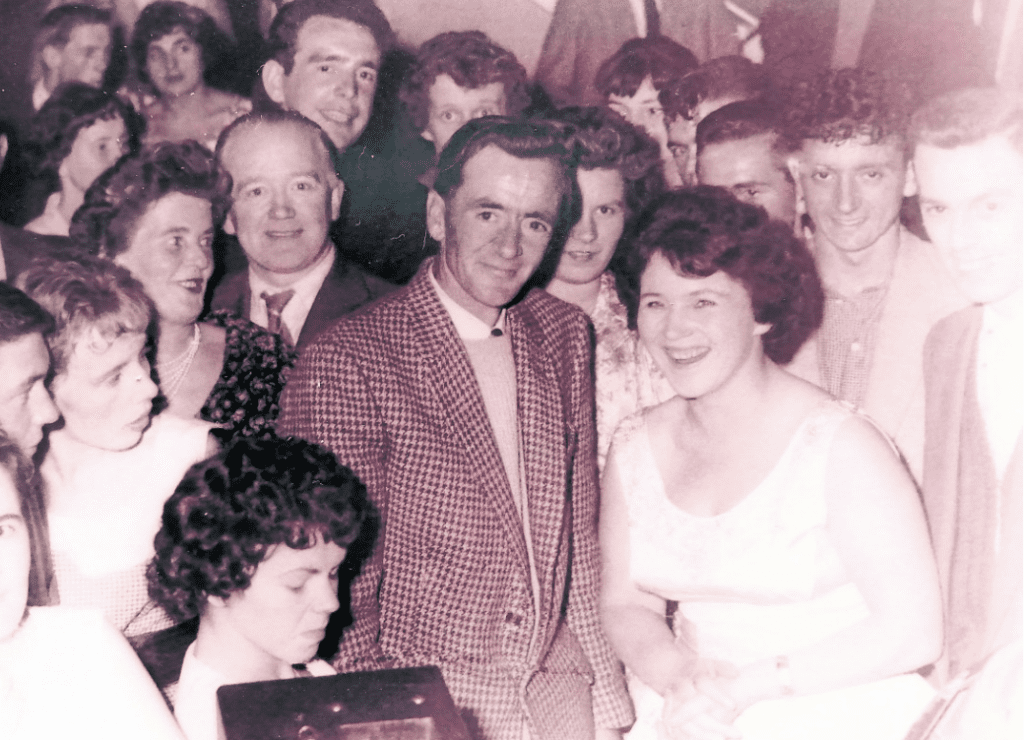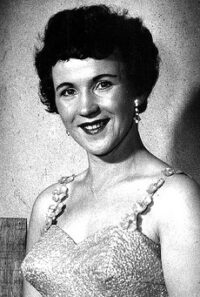By Jim Livingstone
Bridie Gallagher was born near Creeslough, Co Donegal, on the 7th September 1924. She was the second youngest child of James and Bridget Gallagher, with six sisters and three brothers, and lived for most of her childhood years in Ards at the foot of Muckish Mountain.
The Gallaghers were a hard-working family, of modest means, widely respected in the local community, and all active in local sports and music. There was little to suggest in 1924 that this little dark-haired girl might one day become one of the most famous and glamorous singers to come from Ireland, one of its most successful Irish recording artists in the 20th century, performing in many of the great theatres of the world and on TV and radio shows at home and abroad. A far cry from Muckish Mountain and Creeslough.
As a child, Bridie had two great passions; camogie and singing. Along with her sisters Maggie and Grace, she played for the Creeslough camogie team and was widely admired as a fast and talented forward player. But it was her singing that captured most peoples’ attention. She sang on her way to school two miles from home at Massinass National School; she sang at home when helping with household chores; she sang in the choir at Doe chapel. Even when she left school at 14 years of age to work in the post office at Doe, with the post-mistress Annie Hunter, she would sang as she worked; sometimes suffering Annie’s sharp tongue for not concentrating on her work.
So off she went on her very first ‘show-business’ tour around Donegal and Sligo as part of travelling troupe with its singers, musicians, dancers, actors (performing short one-act plays) and even jugglers! But only a few short weeks later she was back home; homesickness drew her back to Creeslough and home!
Bridie returned to work at the post office but, despite the homesickness experienced, she had been smitten by the ‘show-business bug’. She took every opportunity to sing on stage in Creeslough and dreamed of singing in far-away exotic places, just like her idol Vera Lynn.
As was the case for so many young Irish men and women in the late 1940’s, jobs were hard to come by, and all too often emigration was the norm. Bridie’s two eldest brothers emigrated to London. Three older sisters went to Dublin, two of whom later went on to Glasgow to work and live work. Two sisters and one brother stayed in Donegal to later marry and raise families there. Bridie and her sister Grace went to Belfast to live with their Aunt Mary on the Donegall Road and work as ‘domestics’ in the grand houses of the rich on Belfast’s Malone Road. She continued singing, but now in halls (Parish, Orange and Town) in Belfast and around counties Antrim, Down and Armagh.
The singing was initially for fun, but soon she was offered money to sing. Not large fortunes of course, but for a young 23 year old in 1947, a couple of pounds to sing 4 songs on a local variety show was an extremely attractive supplement to the small earnings she had doing domestic work. She was soon contracted to a Belfast show-business agent called Harry Baxter and found herself in growing demand. At that time her repertoire included the ‘chart-toppers’ of the times, mainly songs by Vera Lynn, Rosemary Clooney and Doris Day.
In 1948 Bridie met Bob Livingstone, a Belfast boy who took the same bus to work every morning as her. They fell in love, and married in September 1951 in Dunfanaghy. Bob worked as a coachman, Bridie continued domestic work and singing occasionally in local concerts, and they settled down in a small flat on University Street and later a terrace house in Carmel Street, Belfast.
Her popularity was spreading and she was in demand for concerts in Belfast, Derry, Armagh, Newry; anywhere that variety was promoted. She was still singing the ‘pop-songs’ of that time until one fateful night waiting to go on stage in a concert at St Columb’s Hall in Derry, two local girls performing before her sang every song she planned to sing. She was desperate. What could she do? Then the Belfast taxi-driver who had brought her to Derry for the concert and knew her singing well said “Bridie, give them all those lovely Irish Ballads you sing in the taxi – they’ll love it”. And so she did; the first being The Whistling Gypsy, followed by Glenswilly. The response was amazing! Here were songs long out of fashion but yet clearly not forgotten, with meaning and pathos every member of the audience in Derry that night could understand.
That was the night in 1953 Bridie Gallagher became an Irish ballad singer. It changed her life. In the following months she changed her repertoire and became the girl singer who was different from the rest, with a voice that was unique, often described as “having a tear in her voice” and ideal for Irish ballads. Her popularity grew and suddenly she was in real demand, being paid (a little) better money, placed higher on ‘the bill’, and getting offers of work with big names of the time, such as James Young, to perform in their variety shows.

Then a London talent scout, Dick Roe, from DECCA records came to Belfast to audition singers, one of whom was Bridie. When she sang he immediately heard a voice that was different, a style that was unique, a young woman of great beauty, and recognised a potential star. It was Dick who first described Bridie as the ‘girl witha tear in her voice’. Bridie signed a recording contract there and then and was soon in a recording studio (set up in the Jewish Institute off Belfast’s Antrim Road) with a group of musicians led by Tommy James (who later had his own TV show on UTV ‘Teatime With Tommy’ in the 1960’s) and recorded her very first record A Mother’s Love’s A Blessing which was released in 1956.
The record was an immediate hit – in Scotland! Sales around Ireland were good, but in Scotland, with its large Donegal emigrant population, she became a big success. Demands for her performance really took off. She also signed with her first professional manager, Nelius O’Connell, based in Dublin and was soon singing in concerts, and increasingly theatres rather than parish halls, all over Ireland. Her popularity soared further being a recording artist with records being played almost daily on Radio Eireann.

Performances in theatres like the Theatre Royal in Dublin and Empire Theatre in Belfast become the norm. She was the ‘Top of the Bill’, and more recordings followed. In 1957 she released The Boys from Co Armaghand it established her immediately as Ireland’s top recording artiste selling internationally as well as in Ireland. In 1958 she recorded one of her first albums under the title The Girl from Donegal (one of the tracks). Thereafter on every concert poster and billing she became known as “Bridie Gallagher – The Girl from Donegal”.
By 1958 her career was really reaching a crescendo. She was touring England and Scotland playing more and more of the great theatres in Glasgow (Metropole), Liverpool (Pavillion), Edinburgh (Usher Hall), Aberdeen (His Majesty’s), Leicester (De Monfort), and London (Metropole, Edgeware Road). In that same year she changed management to one of London’s top agencies – Solomon’s. Phil Solomon, originally from Belfast, and his wife Dorothy, were a major influence on how Bridie was presented on stage, and in the media. They introduced glamour to her styling. They insisted on only the best stage gowns, musicians, musical directors – everything had to be top class. Phil told Bridie “In two years I’ll have you at the London Palladium, and I’ll bet you a new car I do it!”.
Bridie continued touring and recording under Solomon’s expert guiding hand attracting more and more praise from critics, fans and promoters. Appearance fees rocketed. The crowds attending were enormous by the standards of the 1950’s and indeed even today, 60 years later. Every promoter recognised Bridie as ‘the big draw’ where audiences numbering thousands were not unknown. She started Summer Seasons in seaside theatres in Dungarvan, Bundoran, Butlins Mosney, Isle of Man, and in 1958 made her very first of 14 tours to the USA working for Harry McGurk in New York, Chicago, Philadelphia and Boston. Life was becoming a hectic whirlwind of travelling, rehearsing, performing, recording and yet more travelling, and by this time all while being mother to two little boys, Jim and Peter.

Then one day in late 1958 Phil Solomon announced to Bridie “I told you I would do it, and I did. You are to perform on Sunday Night at the London Palladium on 4 January 1959”. And she did. And she got her car! A red Singer Sunbeam convertible!
The London Palladium was the pinnacle of her career. Every artist in show-business around the world dreamed of being on that stage. Very few ever lived that dream. But Bridie sang 3 songs that night to critical acclaim in the London newspapers. The televised show was hosted by Bruce Forsyth and also starred the great Swedish tenor Jussi Bjoerling. Overnight Bridie Gallagher was an international star! Everyone wanted her in their theatre, on their TV or radio show, at their parties, and her earnings and fame grew ever more.
More coast-to-coast tours of the USA, England, Scotland, Wales and Ireland followed during the early 1960s, more recordings like “At Home with Bridie Gallagher” (produced by the Beatles’ George Martin) selling in vast numbers. More great venues were in her itinerary such as the Albert Hall in London to record audiences of over 7,000, and at the other extreme an open air concert in Killmanham Wood in Co Meath singing on the back of a lorry with her pianist to a crowd estimated to be over 6,000 people. Every promoter knew “Bridie pulls in the biggest crowds”. As she toured internationally she met many major celebrities such as Pat Boone, Ginger Rodgers, Jim Reeves and his wife Mary, and shared great stages with The Bachelors and Petula Clark in London, Johnny Cash in San Francisco, and the Clancy Brothers in New York.
As the 1960s passed by Bridie continued performing, but with the advent of the Beatles era and the new “pop music” saw the demise of interest in variety theatre and the growth of cabaret lounges in Ireland and Britain. Bridie made the switch in style almost effortlessly and was able to apply her well-developed stage skills crafted on the biggest stages of the world to very good effect in cabaret. She became widely recognised as a very stylish and entertaining cabaret artist who never performed for less than 60 minutes any night and always insisted on perfection in performances including glamorous gowns.
She continued with annual trips to the USA and in 1977 at last achieved a long-held ambition to appear at the Sydney Opera House in Australia which only opened four years earlier and was thus one of the very first Irish singers to appear on its stage. A few years later she did her first tour to Africa singing at Irish centres in Zambia and Milawi. Travelling, however, was beginning to take its toll and, as she passed her 60th birthday in 1984, she began to slow down the hectic pace and more and more sing only at venues that she liked.
She refused to “retire” and still found promoters, especially in the USA, wanting her to tour. Her last trip to the USA was for a major concert at New York’s Lincoln Centre in 1992. She continued with records, recording 12 albums and 32 singles in total and produced two videos in the 1990’s. But eventually, on 14 August 2000, she performed her last show at the An Grainnan Theatre in Letterkenny during the Letterkenny Reunion Festival. That night, just three weeks short of her 76th birthday, she performed with just as much style and flair as many years earlier, with a slightly weaker voice, but still expressing sentiments in song just as strong as when much younger, accompanied on guitar by her son Jim and on piano by her granddaughter Teresa. She told no one other than Jim that it was her last performance. She told Jim “Tell no one, but that’s the last. I’m too tired”.
She never sang publicly again – but still never announced her retirement. In July 2000, a few weeks before her last performance, the people of Creeslough paid her an immense tribute by erecting and dedicating a sign in the town to her memory, welcoming people to Creeslough the home of Bridie Gallagher, The Girl from Donegal. She was also very touched that day at the presence of her good friends Daniel O’Donnell and his sister Margo who led the tributes to her on the day. As Daniel said “Bridie led the way for us all”. The following day she was entertained to a Civic Reception by Donegal County Council in Lifford. They were two of her proudest days, and she cried heartfelt tears of thanks. A few months later Bridie suffered the first of 5 strokes she was to endure over the next five years.
Bridie’s health gradually deteriorated until on the 9th January 2012, following a short illness, she died, in a Belfast hospital, peacefully and with her family by her side. She had lived most of her life in Belfast, but by an amazing coincidence, a water-colour painting hanging on the wall across from her hospital bed, was a view of Muckish Mountain from the White Gate at Ards – one of Bridie’s favourite places from childhood.
So Bridie Gallagher, the Girl from Donegal, who sang in Massinass School Choir and Creeslough Hall, the young woman who went on to sing on the stage of Theatre Royal Dublin, Albert Hall London, Sydney Opera House, Lincoln Centre New York and The London Palladium, and became known to millions of Irish people across the world, left this world in sight of Muckish Mountain and Creeslough.
© Jim Livingstone
You can watch a video of Bridie being laid to rest below

